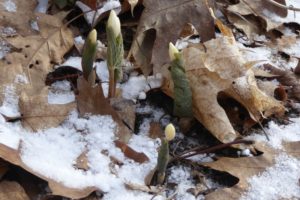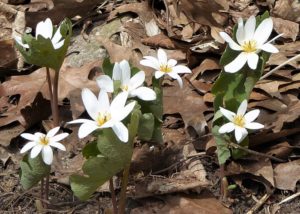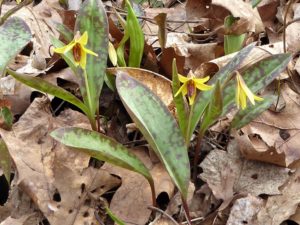Lockdown Blues
Everyone is beginning to feel the strain of two and half month’s lockdown. It started in late winter and has lasted well into spring. It has been good to be able to get outside more, and see the progress of spring. The warmer weather has accelerated the growth of leaves, and most trees are now fully leafed out. At the same time, early spring wildflowers, such as bloodroots, trilliums, and trout lilies have disappeared. This is not a coincidence.
 These early spring flowers are called ephemerals. They begin to appear in late April, and within the space of a month grow to maturity, produce seeds, and produce and store enough nutrients in their root systems to last them for the next 11 months. An amazing lifecycle, and an adaptation these plants have made for survival in northern hardwood forests. Green plants rely on sunlight to produce the food and energy they need to grow and reproduce. In northern hardwood forests large deciduous trees dominate the canopy, and the forest floor is in deep shade for most of the growing season. There is a brief period in the spring, however, before the deciduous trees fully leaf out, when the forest floor is in full sunlight.
These early spring flowers are called ephemerals. They begin to appear in late April, and within the space of a month grow to maturity, produce seeds, and produce and store enough nutrients in their root systems to last them for the next 11 months. An amazing lifecycle, and an adaptation these plants have made for survival in northern hardwood forests. Green plants rely on sunlight to produce the food and energy they need to grow and reproduce. In northern hardwood forests large deciduous trees dominate the canopy, and the forest floor is in deep shade for most of the growing season. There is a brief period in the spring, however, before the deciduous trees fully leaf out, when the forest floor is in full sunlight.
 Spring ephemerals have adapted to take advantage of this period, and complete the active phase of their life in the space of a month. The warm spring sun on the forest floor gives them a head start, and they appear before most other plants. The attached photograph of bloodroot shoots shows them surviving a late winter snowfall, the next, the same plants about a week later in full flower. One of the striking sights of spring is to see the forest floor turn green with extensive stands of trout lily leaves, only to see them all disappear within a couple of weeks. So, if you are feeling oppressed by the long period of lockdown we have been experiencing, be thankful you didn’t arrive as a spring ephemeral, with each year, one month in the sun and eleven in lockdown!
Spring ephemerals have adapted to take advantage of this period, and complete the active phase of their life in the space of a month. The warm spring sun on the forest floor gives them a head start, and they appear before most other plants. The attached photograph of bloodroot shoots shows them surviving a late winter snowfall, the next, the same plants about a week later in full flower. One of the striking sights of spring is to see the forest floor turn green with extensive stands of trout lily leaves, only to see them all disappear within a couple of weeks. So, if you are feeling oppressed by the long period of lockdown we have been experiencing, be thankful you didn’t arrive as a spring ephemeral, with each year, one month in the sun and eleven in lockdown!
 CPAWS Ottawa Valley works to ensure the survival of these amazing plants, by seeking protection of the native forests in which they grow. We rely on your support to continue to be a strong voice for nature in the region.
CPAWS Ottawa Valley works to ensure the survival of these amazing plants, by seeking protection of the native forests in which they grow. We rely on your support to continue to be a strong voice for nature in the region.
Brian Roadhouse
